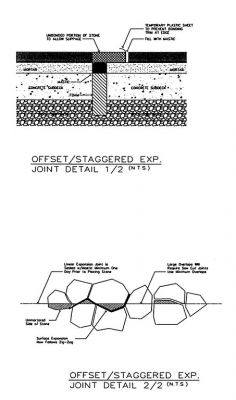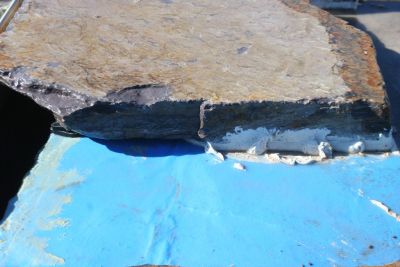Expansive Tendencies
By Paolo Benedetti
 In this new article series, watershaper Paolo Benedetti shares years of experience in providing clients with custom details and, as the series title suggests, offering solutions that can be applied in the field to carry them off. This time, it’s all about isolation and crack-control joints and ways to avoid making aesthetic sacrifices in the installation of stone coping and deck veneers atop them.
In this new article series, watershaper Paolo Benedetti shares years of experience in providing clients with custom details and, as the series title suggests, offering solutions that can be applied in the field to carry them off. This time, it’s all about isolation and crack-control joints and ways to avoid making aesthetic sacrifices in the installation of stone coping and deck veneers atop them.
Oftentimes, I end up wanting to use irregularly shaped or large, dimensional stones as a coping for my clients’ pools and as a veneer in finishing their decks.
I know in doing so, of course, that the deck and its stone veneer must be isolated from the pool structure and the coping. I also know, of course, that random or dimensional stone generally doesn’t conveniently follow the isolation joint around the back edge of the bond beam. Nor, for that matter, will the stone pieces used in the deck align with the control joints I’ve established in the concrete slab.
So how do I manage to make this all work without the ugly option of cutting the coping stones or the deck veneer to follow the joints? You’ll find the answer in the approach described here:
[ ] Prepare and place the concrete substrate as usual – that is, in such a way that the decking does not touch the edge of the pool structure at any point. Typically, this entails installation of a layer of closed-cell foam. (We use a custom, half-inch-thick product that comes in eight- to 12-inch widths instead of the readily available three-and-a-half-inch-wide material to make certain there’s no chance at all of direct contact.)
 Achieving this sort of look – that is, a beautiful stone surface without the awkward visual break that frequently marks the boundary between the coping and the surrounding deck – takes some finesse, but it’s attainable by carefully using mortar and a bond-breaking material to let part of the stone ‘float’ on one side or other of the isolation joint.
Achieving this sort of look – that is, a beautiful stone surface without the awkward visual break that frequently marks the boundary between the coping and the surrounding deck – takes some finesse, but it’s attainable by carefully using mortar and a bond-breaking material to let part of the stone ‘float’ on one side or other of the isolation joint.

[ ] Next, float the subdeck with mortar to a level that accommodates the thickness of the stone veneer, extending the isolation joint up through the mortar to the surface.
[ ] Seal the isolation joint with a polyurethane sealant, always using a good-quality material: It will never be seen again and must withstand the tests of time.
[ ] Install a crack-control membrane on top of the bond beam and out onto the deck, spanning the top of the isolation joint. (We generally use the woven, cloth-reinforced Crack Control Membrane made by Laticrete of Bethany, Conn.)
[ ] Position the random stone pattern on top of the crack-control membrane, using a quality thin-set mortar if you’re setting a gauged stone or tile, or a “wet-set” method if you’re using a natural stone that varies in thickness. The individual stones are placed into the wet mortar bed, and any excess that oozes out is trimmed away.

At this point in the process, the boundary between the bond beam and the subdeck is hidden beneath a mass of mortar we applied in preparation for placement of the next stone. As you can see, only the portion of the stone to the right side of the joint has been mortared to the substrate, allowing the rest of the stone to reach over and float freely above the bond beam.
The trick with this detail is ensuring that the stone on one side of the joint is always “floating” – in other words, that it is not bonded to the substrate. This is accomplished by placing a layer of plastic tape, visqueen or sheet plastic between the stone and the wet mortar on just one portion of the stone. In the example shown here, for instance, we chose the side of the stone with the smaller surface area to be the free-floating side.
Once installed, the stone is still in contact with the mortar bed and so is still fully supported. But the plastic functions as a “bond breaker,” allowing the stone to slip with any movement. And in those spots where we need to cantilever a rather thick stone over, say, a gutter or slot detail, we’ll epoxy the rear portion of the stone to the deck, leaving the front portion to float over the bond beam, with or without supporting mortar depending on the detail.
[ ] Use this same bond-breaker approach where a stone in the deck pattern bridges any of the slab’s crack-control joints. (Often, by the time we get around to applying the veneers, additional cracks will have appeared: We treat these the same way we do the control joints, basically because these are places where we know cracking will occur.)
[ ] Perform any pressure-washing or sandblasting or sealing of the installed stone before installing the grout. (In applying sealers, we take special care not to let the material flow down into the joints.)
[ ] Once the regular grouting is done, go back and fill the staggered joints of the “floating” stones with a quality mastic topped with decorative sand. The sand makes the mastic match the grout and also offers some ultraviolet protection to the mastic.
The coping and decking are done, and we have the satisfaction of knowing that we didn’t sacrifice the aesthetics of irregularly shaped materials to our need to respect isolation and crack-control joints.
A Stable Base
As is true with any flatwork project, success in the type of detail described in the accompanying text is completely dependent upon your having installed a stable concrete slab. None of the procedures described in the text will work if the stone material is applied over a thin concrete slab poured over an improperly prepared sub-base!
To ensure years of crack-free enjoyment, you need to install a steel-reinforced concrete slab of adequate thickness over a properly prepared sub-base – and make certain it’s all done within parameters defined in the project’s geotechnical report.
